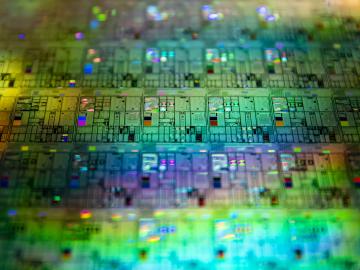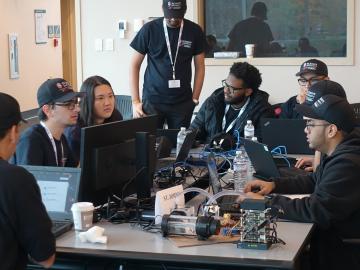
Filter News
Area of Research
- (-) National Security (46)
- (-) Supercomputing (86)
- Advanced Manufacturing (13)
- Biology and Environment (120)
- Biology and Soft Matter (1)
- Building Technologies (2)
- Computational Engineering (2)
- Computer Science (12)
- Electricity and Smart Grid (3)
- Energy Science (185)
- Energy Sciences (1)
- Fuel Cycle Science and Technology (1)
- Functional Materials for Energy (1)
- Fusion and Fission (33)
- Fusion Energy (11)
- Isotope Development and Production (1)
- Isotopes (6)
- Materials (125)
- Materials Characterization (1)
- Materials for Computing (17)
- Materials Under Extremes (1)
- Mathematics (1)
- Neutron Science (41)
- Nuclear Science and Technology (38)
- Nuclear Systems Modeling, Simulation and Validation (1)
- Quantum information Science (9)
- Sensors and Controls (1)
- Transportation Systems (1)
News Topics
- (-) Cybersecurity (23)
- (-) Environment (26)
- (-) Grid (11)
- (-) Machine Learning (24)
- (-) Materials Science (17)
- (-) Nuclear Energy (8)
- (-) Partnerships (5)
- (-) Quantum Science (26)
- 3-D Printing/Advanced Manufacturing (7)
- Advanced Reactors (2)
- Artificial Intelligence (46)
- Big Data (25)
- Bioenergy (11)
- Biology (14)
- Biomedical (17)
- Biotechnology (3)
- Buildings (4)
- Chemical Sciences (5)
- Computer Science (105)
- Coronavirus (16)
- Critical Materials (3)
- Energy Storage (9)
- Exascale Computing (26)
- Frontier (32)
- Fusion (2)
- High-Performance Computing (45)
- Isotopes (2)
- Materials (16)
- Mathematics (2)
- Microscopy (7)
- Molten Salt (1)
- Nanotechnology (11)
- National Security (36)
- Neutron Science (15)
- Physics (9)
- Polymers (2)
- Quantum Computing (20)
- Security (15)
- Simulation (16)
- Software (1)
- Space Exploration (3)
- Summit (43)
- Transportation (8)
Media Contacts

A novel approach developed by scientists at ORNL can scan massive datasets of large-scale satellite images to more accurately map infrastructure – such as buildings and roads – in hours versus days.

The prospect of simulating a fusion plasma is a step closer to reality thanks to a new computational tool developed by scientists in fusion physics, computer science and mathematics at ORNL.

An international team of researchers has discovered the hydrogen atoms in a metal hydride material are much more tightly spaced than had been predicted for decades — a feature that could possibly facilitate superconductivity at or near room temperature and pressure.

A team from the ORNL has conducted a series of experiments to gain a better understanding of quantum mechanics and pursue advances in quantum networking and quantum computing, which could lead to practical applications in cybersecurity and other areas.

Scientists at have experimentally demonstrated a novel cryogenic, or low temperature, memory cell circuit design based on coupled arrays of Josephson junctions, a technology that may be faster and more energy efficient than existing memory devices.

To better determine the potential energy cost savings among connected homes, researchers at Oak Ridge National Laboratory developed a computer simulation to more accurately compare energy use on similar weather days.

Students often participate in internships and receive formal training in their chosen career fields during college, but some pursue professional development opportunities even earlier.

Oak Ridge National Laboratory will give college students the chance to practice cybersecurity skills in a real-world setting as a host of the Department of Energy’s fifth collegiate CyberForce Competition on Nov. 16. The event brings together student teams from across the country to compete at 10 of DOE’s national laboratories.

Researchers at the Department of Energy’s Oak Ridge National Laboratory have received five 2019 R&D 100 Awards, increasing the lab’s total to 221 since the award’s inception in 1963.

A joint research team from Google Inc., NASA Ames Research Center, and the Department of Energy’s Oak Ridge National Laboratory has demonstrated that a quantum computer can outperform a classical computer


